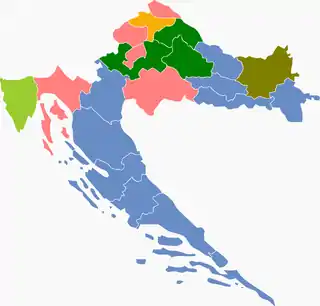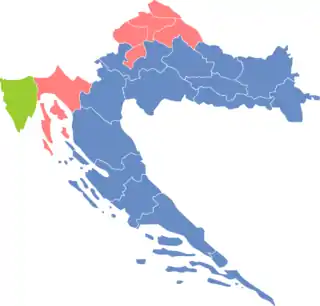2009 Croatian local elections
The 2009 Croatian local elections were held on 17 May, with the second round held on 31 May where necessary.
| |||||||||||||||||||||||||
| |||||||||||||||||||||||||
 | |||||||||||||||||||||||||
 Map of the results of the council elections in each county. The relative winners: HDZ coalition SDP coalition IDS coalition | |||||||||||||||||||||||||
 |
|---|
| This article is part of a series on the politics and government of Croatia |
The elections were held to elect members of city councils, mayors, members of county councils and county prefects. These were the first elections in which mayors and county prefects were elected directly by popular vote, rather than by a majority coalition in the council. The new system allowed many independent politicians to run against big party nominees. Many cities elected independent mayors, most notable being Split, Croatia's second largest city and Kaštela. As a result many cities and counties elected opposite lists for mayoral and council elections causing a larger number of cohabitation local governments.
Election results
The Croatian Democratic Union won the largest number of cities and counties carrying ten prefect elections, thirteen in coalition, and fifteen council elections largely in coalition with the Croatian Peasant Party and the Croatian Social Liberal Party. The Social Democratic Party of Croatia won five prefect elections, seven in coalitions, and six council elections mostly in coalition with the Croatian People's Party - Liberal Democrats and the Istrian Democratic Assembly. The social democrats fared better in mayoral elections as well as in city council elections. They made considerable gains in Dalmatia winning certain traditionally HDZ leaning cities such as Dubrovnik, Šibenik and Trogir and also managed to win Vukovar, a city that was almost destroyed in the Croatian War of Independence and was since a HDZ stronghold. They also kept economically the most powerful parts of the country, Zagreb, Rijeka and, in coalition, Istria. HDZ lost Split and Osijek, the second and the fourth most populous cities in the country respectively, but held Zadar.
| Results of 2009 Croatian local elections | |||||||
|---|---|---|---|---|---|---|---|
| County | County council | County prefect/Zagreb mayor | |||||
| Plurality | Turnout | Prefect/Mayor | Turnout | Notes | |||
| Bjelovar-Bilogora | HDZ (28.9%) | 44.0% | Miroslav Čačija, HSS (64.4%) | 44.0% | first round win | ||
| Brod-Posavina | HDZ (32.2%) | 47.8% | Danijel Marušić, HDZ (50.9%) | 36.2% | runoff election | ||
| Dubrovnik-Neretva | HDZ (46.7%) | 55.4% | Nikola Dobroslavić, HDZ (53.6%) | 49.1% | runoff election | ||
| Istria | IDS (44.8%) | 49.6% | Ivan Jakovčić, IDS (59.6%) | 38.2% | runoff election | ||
| Karlovac | HDZ (48.3%) | 46.3% | Ivan Vučić, HDZ (58.7%) | 30.3% | runoff election | ||
| Koprivnica-Križevci | SDP (45.9%) | 53.1% | Darko Koren, HSS (51.2%) | 53.1% | first round win | ||
| Krapina-Zagorje | SDP (46.3%) | 52.7% | Siniša Hajdaš Dončić, SDP (53.0%) | 52.7% | first round win | ||
| Lika-Senj | HDZ (69.9%) | 50.5% | Milan Jurković, HDZ (68.5%) | 50.5% | first round win | ||
| Međimurje | SDP (40.0%) | 50.2% | Ivan Perhoč, SDP (62.8%) | 37.3% | runoff election | ||
| Osijek-Baranja | HDZ (34.7%) | 49.2% | Vladimir Šišljagić, HDSSB (54.1%) | 38.7% | runoff election | ||
| Požega-Slavonia | HDZ (40.4%) | 49.9% | Marijan Aladrović, HDZ (53.0%) | 43.7% | runoff election | ||
| Primorje-Gorski Kotar | SDP (52.3%) | 44.1% | Zlatko Komadina, SDP (60.5%) | 44.1% | first round win | ||
| Sisak-Moslavina | HDZ (40.1%) | 44.4% | Marina Lovrić, SDP (50.9%) | 44.4% | first round win | ||
| Split-Dalmatia | HDZ (31.7%) | 49.3% | Ante Sanader, HDZ (58.7%) | 42.8% | runoff election | ||
| Šibenik-Knin | HDZ (35.6%) | 46.8% | Goran Pauk, HDZ (62.7%) | 30.2% | runoff election | ||
| Varaždin | HNS (52.9%) | 57.7% | Predrag Štromar, HNS (51.6%) | 57.7% | first round win | ||
| Virovitica-Podravina | HDZ (53.7%) | 50.0% | Tomislav Tolušić, HDZ (57.0%) | 49.7% | first round win | ||
| Vukovar-Syrmia | HDZ (59.2%) | 42.2% | Božo Galić, HDZ (67.9%) | 43.2% | first round win | ||
| Zadar | HDZ (63.3%) | 44.8% | Stipe Zrilić, HDZ (62.9%) | 44.8% | first round win | ||
| Zagreb County | HDZ (42.3%) | 45.8% | Stjepan Kožić, HSS (51.1%) | 45.8% | first round win | ||
| City of Zagreb | SDP (33.3%) | 41.7% | Milan Bandić, SDP (61.8%) | 33.6% | runoff election | ||
| Source: State Electoral Commission[2] Notes: Council majority need not include the party winning plurality in the council. Party affiliations of the prefects and the Zagreb mayor may change during the term. | |||||||
References
- Results Archived 2013-06-07 at the Wayback Machine
- "Arhiva izbora" [Elections Archive] (in Croatian). State Election Commission. Retrieved 13 November 2011.